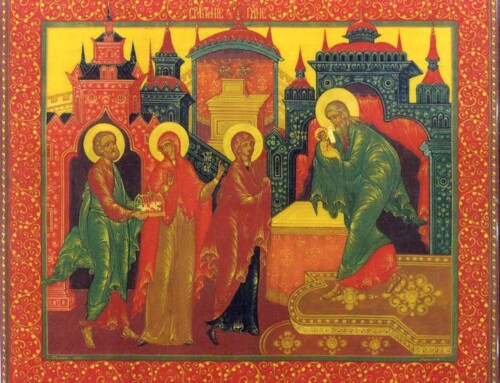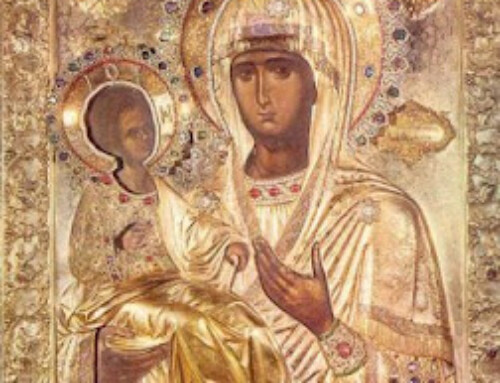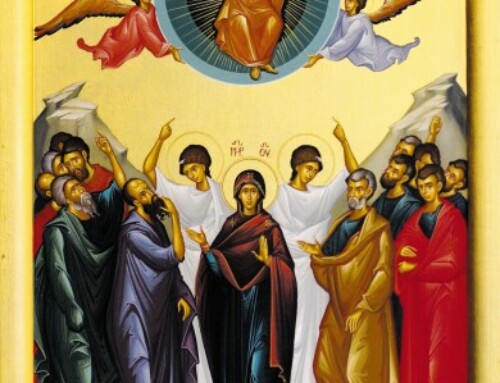The Placing of the Venerable Robe of the Most Holy Theotokos at Blachernae: During the reign of the Byzantine Emperor Leo the Great (457-474), the brothers Galbius and Candidus, associates of the emperor, set out from Constantinople to Palestine to venerate the holy places. In a small settlement near Nazareth they stayed in the home of a certain old Jewish woman. In her house they noticed a room where many lamps were lit, incense burned, and sick people were gathered. When they asked her what the room contained, the pious woman did not want to give an answer for a long time. After persistent requests, she said that she had a very precious sacred item: the Robe of the Mother of God, which performed many miracles and healings. Before Her Dormition the Most Holy Virgin bequeathed one of her garments to a pious Jewish maiden, an ancestor of the old woman, instructing her to leave it to another virgin after her death. Thus, the Robe of the Mother of God was preserved in this family from generation to generation.
The jewelled chest, containing the sacred Robe, was transferred to Constantinople. St Gennadius, Patriarch of Constantinople (August 31), and the emperor Leo, having learned of the sacred treasure, were convinced of the incorrupt state of the holy Robe, and they certified its authenticity. At Blachernae, near the seacoast, a new church in honor of the Mother of God was constructed. On June 2, 458 St Gennadius transferred the sacred Robe into the Blachernae church with appropriate solemnity, placing it within a new reliquary.
Afterwards, the maphorion (i.e., the outer robe) of the Mother of God, and part of Her belt were also put into the reliquary with Her Robe. This circumstance also influenced the Orthodox iconography of the Feast, in connecting the two events: the Placing of the Robe, and the Placing of the Belt of the Mother of God in Blachernae. The Russian pilgrim Stephen of Novgorod, visiting Constantinople in about the year 1350, testifies: “We arrived at Blachernae, where the Robe lies upon an altar in a sealed reliquary.”
More than once, during the invasion of enemies, the Most Holy Theotokos saved the city to which She had given Her holy Robe. Thus it happened during the time of a siege of Constantinople by the Avars in 626, by the Persians in 677, and by the Arabs in the year 717. Especially relevant for us are events of the year 860, intimately connected with the history of the Russian Church.
On June 18, 860 the Russian fleet of Prince Askold, a force comprising more than 200 ships, laid waste the coastal regions of the Black Sea and the Bosphorus, then entered into the Golden Horn and threatened Constantinople. The Russian ships sailed within sight of the city, setting ashore troops who “proceeded before the city, stretching forth their swords.” The emperor Michael III (842-867), interrupted his campaign against the Arabs and returned to the capital. All night he prayed prostrated upon the stone tiles of the church of the Mother of God at Blachernae. The holy Patriarch Photius spoke to his flock, calling for tears of repentance to wash away sins, and to seek the intercession of the Most Holy Theotokos with fervent prayer.
The danger grew with each passing hour. “The city was barely able to stand against a spear,” says Patriarch Photius in another of his homilies. Under these conditions the decision was made to save the church’s sacred objects, especially the holy Robe of the Mother of God, which was kept in the Blachernae church, not far from the shore.
After serving an all-night Vigil, and taking it out from the Blachernae church, they carried the sacred Robe of the Mother of God in a procession around the city walls. They dipped its edge into the waters of the Bosphorus, and then they transported it to the center of Constantinople into the church of Hagia Sophia. The Mother of God protected the city and quelled the fury of the Russian warriors. An honorable truce was concluded, and Askold lifted the siege of Constantinople.
On June 25 the Russian army began to leave, taking with them a large tribute payment. A week afterwards, on July 2, the wonderworking Robe of the Mother of God was solemnly returned to its place in the reliquary of the Blachernae church. In remembrance of these events an annual feastday of the Placing of the Robe of the Mother of God was established on July 2 by holy Patriarch Photius.
Soon, in October-November of the year 860, a Russian delegation arrived in Constantinople to conclude a treaty “in love and peace.” Some of the conditions of the peace treaty included articles concerning the Baptism of Kievan Rus, the payment of an annual tribute by the Byzantines to the Russians, permission for them to serve with the Byzantine army, an agreement to trade in the territory of the Empire (primarily in Constantinople), and to send a diplomatic mission to Byzantium.
Most important was the point about the Baptism of Rus. The continuator of the Byzantine “Theophanes Chronicles” relates that “their delegation arrived in Constantinople with a request for them to receive holy Baptism, which also was fulfilled.” An Orthodox mission was sent to Kiev to fulfill this mutual wish of the Russians and the Greeks. Not very long before this (in 855) St Cyril the Philosopher (February 14 and May 11) had created a Slavonic alphabet and translated the Gospel. St Cyril was sent with his brother, St Methodius (April 6 and May 11), on a mission to Kiev with books translated into Slavonic. This was at the initiative of St Photius, whose student St Cyril was. The brothers spent the winter of 860/861 at Cherson, and in the spring of 861 they were at the River Dniepr, with Prince Askold.
Prince Askold was faced with a difficult choice, just as holy Prince Vladimir faced: both the Jews on the one hand, and the Moslems on the other, wanted him to accept their faith. But under the influence of St Cyril, the prince chose Orthodoxy. At the end of the year 861, Sts Cyril and Methodius returned to Constantinople and carried letters with them from Prince Askold to Emperor Michael III. Askold thanked the emperor for sending him “such men, who showed by both word and by example, that the Christian Faith is holy.” “Persuaded that this is the true Faith,” Askold further wrote, “we bid them to baptize in the hope that we may also attain sanctity. We are all friends of the Kingdom and prepared to be of service to you, as requested.”
Askold accepted holy Baptism with the name Nicholas, and many of his retinue were also baptized. Directly from Constantinople, the capital of Orthodoxy, through the efforts of the holy Apostles to the Slavs both the Slavonic divine services and the Slavonic written language arrived in Rus.
St Photius appointed Metropolitan Michael to Kiev, and the Russian metropolitan district was entered into the lists of dioceses of the Patriarchate of Constantinople. Patriarch Photius in an encyclical of the year 867 called the Baptism of the Bulgarians and the Russians as among the chief accomplishments of his archpastoral service. “The Russians, who lifted their hand against the Roman might,” he wrote, almost quoting literally from the missive of Askold, “have now replaced the impious teaching which they held to formerly, with the pure and genuine Christian Faith, and with love having established themselves in the array of our friends and subjects.” (The Byzantines counted as “subjects” all accepting Baptism from Constantinople and entering into military alliance with the Empire.) “The desire and zeal of faith has flared up within them to such an extent, that they have accepted bishops and pastors, and they embrace Christian sanctity with great zeal and fervor.”
The Feast of the Placing of the Robe of the Most Holy Theotokos in Blachernae also marks the canonical establishment of the Russian Orthodox metropolitanate in Kiev. By the blessing of the Mother of God and by the miracle from Her holy Robe not only was the deliverence of Constantinople from the most terrible siege in all its history accomplished, but also the liberation of the Russians from the darkness of pagan superstition to life eternal. Together with this, the year 860 brought recognition to Kievan Rus from Byzantium, and signified the emergence of the young Russian realm into the arena of history.
The attempt of Prince Askold to renew the Christian evangelization begun by the holy Apostle Andrew the First-Called, which he intended as a religious and state reform, ended unsuccessfully. The time for the spread of Christianity in the Russian Land had not yet come. The adherents of the old paganism were too strong, and the princely power was too weak. In the clash of Askold with the pagan Oleg in 882 the Kievans betrayed their prince. Askold, lured into the camp of his enemies for talks, received a martyr’s death at the hand of hired killers.
But the deed of Blessed Askold (the Ioakimov Chronicle calls him such) was not extinguished in the Russian Church. Oleg the Sage, who killed Askold, occupied the Kiev princedom after him, and called Kiev the “Mother of Russian Cities.”
The most ancient chronicles of Kiev preserved the grateful memory of the first Kievan Christian prince: the church of the Prophet of God Elias, built by Askold and later mentioned in Igor’s Treaty with the Greeks (in 944), is on the site where the present church of this name now stands, and there is also the church of St Nicholas the Wonderworker, built in the 950s by St Olga over Askold’s grave.
The most important achievement of Askold, entering forever into the Church inheritance not only of Rus, but of also all Orthodox Slavs, is the Slavonic Gospel and Slavonic services, translated by Sts Cyril and Methodius. Their apostolic activity among the Slavs began in Kiev at the court of Askold in 861, and continued afterwards in Moravia and Bulgaria. Following Blessed Askold, in the words of the ancient Alphabetic Prayers, “the Slavonic tribe now soars in flight, all striving toward Baptism.”
Several outstanding works of Byzantine Church hymnology and homiletics are connected with the miracle of the Robe of the Most Holy Theotokos at Blachernae. There are two homilies of St Photius, one of which he preached within days of the siege of Constantinople, and the other soon after the departure of the Russian forces. Also associated with the campaign of Askold against Constantinople is the composition of a remarkable “Akathist to the Most Holy Theotokos,” which certain Church histories ascribe also to holy Patriarch Photius. This Akathist forms an integral part of the services of Praise to the Most Holy Theotokos (i.e., the “Saturday of the Akathist,” Fifth Saturday of Great Lent).
It is not only Byzantine sources that relate the events of the year 860, but also Russian historical chronicles. St Nestor the Chronicler, stressing the significance of the Russian campaign against Constantinople, notes that from this time “it was begun to be called the Russian Land.” Certain of the chronicles, among them the Ioakimov and Nikonov, preserved accounts of the Baptism of Prince Askold and Kievan Rus after the campaign against Constantinople. The popular commemoration of this event is firmly associated with the names of the Kievan princes Askold and Dir, although in the opinion of historians, Dir was prince of Kiev somewhat earlier than Askold.
The veneration of the feast of the Placing of the Robe was long known in the Russian Church. St Andrew Bogoliubsky (July 4) built a church in honor of this feastday in the city of Vladimir at the Golden Gates. At the end of the fourteenth century, part of the Robe of the Mother of God was transferred from Constantinople to Rus by St Dionysius, Archbishop of Suzdal (June 26).
The holy Robe of the Mother of God, which previously saved Constantinople, later saved Moscow from hostilities. Tatars of the Horde of the princeling Mazovshi approached the walls of Moscow in the summer of 1451. St Jonah, Metropolitan of Moscow, with constant prayer and church services, encouraged the defenders of the capital. On the night of July 2, the Chronicle relates, great confusion occurred within the Tatar camp. The enemy abandoned their plundered goods and speedily departed in disarray. In memory of the miraculous deliverance of Moscow, St Jonah built the church of the Placing of the Robe in the Kremlin, making it his primary church. It burned, but in its place in the years 1484-1486 a new church, also dedicated to the Feast of the Placing of the Robe of the Mother of God, was built thirty years later. This temple, standing at present, continued to serve as the primary church of Russian metropolitans and patriarchs until the cathedral of the Twelve Apostles was built under Patriarch Nikon.
Troparion – Tone 8
Ever-Virgin Theotokos, protectress of mankind, you have given given your people a powerful powerful legacy: the robe and sash of your most honored body, which remained incorrupt throughout your seedless childbearing; for through you time and nature are renewed! Therefore we implore you: “Grant peace to your people and to our souls great mercy!”
Kondakion – Tone 4
O Pure One, full of the grace of God, you have given your sacred robe as a garment of incorruption to all the faithful, with it you covered your holy body, O divine protection of all mankind. We celebrate its enshrinement in Blachérnae with love and we cry aloud with awe: “Rejoice, O Virgin, boast of Christians.”
 |






